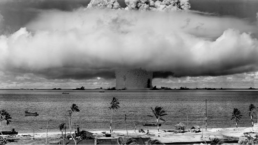Cutting drastically the number of U.S. nuclear weapons should not depend on Russian or Chinese assent and could and should be considered now.
By John Isaacs, The National Interest
The dawn of the nuclear age changed every aspect of military calculations except for, unfortunately, the Pentagon’s counting skills. The United States continues to bear the consequences of this failure every day.

With the advent of the nuclear age in 1945, the world discovered that a single bomb could destroy a city, and a large number of bombs could wipe out much of life on Earth.
Up to then, counts of weapons and personnel were key measures of power in war and peace. Such arithmetic lost its meaning with the advent of these new devastating weapons.
In the nuclear age, a country that deployed 1,000 nuclear weapons rather than an adversary’s 500 is not twice as powerful since a handful of weapons could devastate both countries. But the Pentagon and political leaders did not learn this critical lesson.
Instead, during the Cold War, both the United States and the Soviet Union engaged in massive buildups of nuclear weapons—in the tens of thousands. The numbers games fed an arms race that, despite the post-Cold War reductions, continues to influence strategic thinking today without making either Russia, the Soviet Union’s successor, or the United States safer. In other words, the Pentagon and political leaders still have not learned that counts of military strength are not the same when nuclear weapons are involved.
Recent Posts
‘Unconstitutional. Unethical. Authoritarian.’ ICE Bars Millions Of Immigrants From Bond Hearings
July 18, 2025
Take Action Now One watchdog said the new policy “seems like a blatant attempt to stop them from exercising their right to due process.”……
Americans Are Not Nearly Alarmed Enough About Climate Change
July 18, 2025
Take Action Now Americans still don’t comprehend how imminent, dangerous, and far-reaching the threat is—and journalists are partly to blame.By…
The IRS Is Building A Vast System To Share Millions Of Taxpayers’ Data With ICE
July 17, 2025
Take Action Now ProPublica has obtained the blueprint for the Trump administration’s unprecedented plan to turn over IRS records to Homeland Security…
Israel’s Sudden Assault On Syria Is Unchecked Aggression
July 17, 2025
Take Action Now Jerusalem is bombing Damascus and threatening al-Sharaa’s rule, while Washington was hoping to help the nascent government on…




